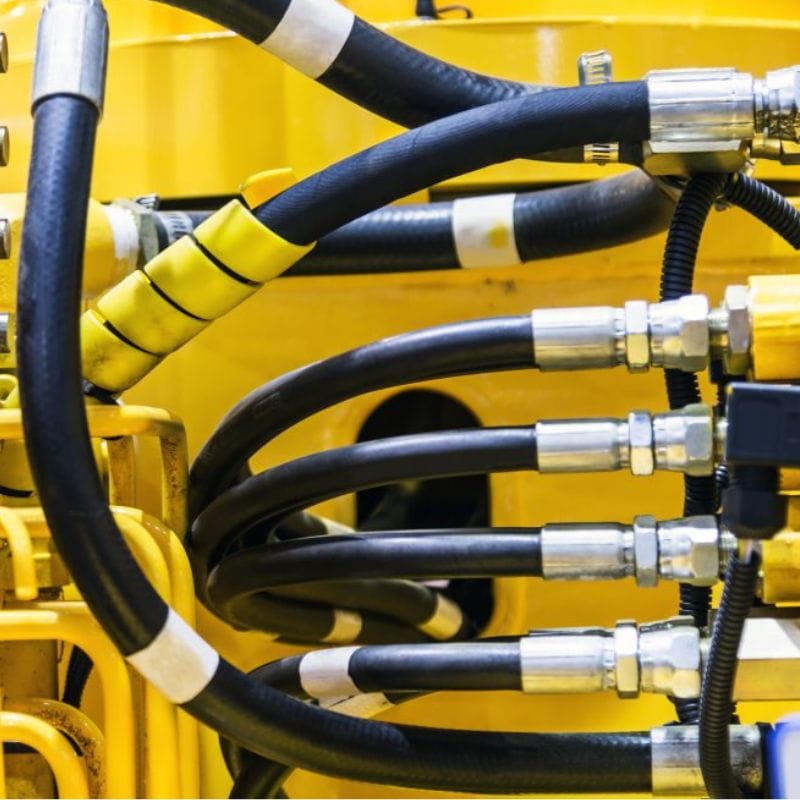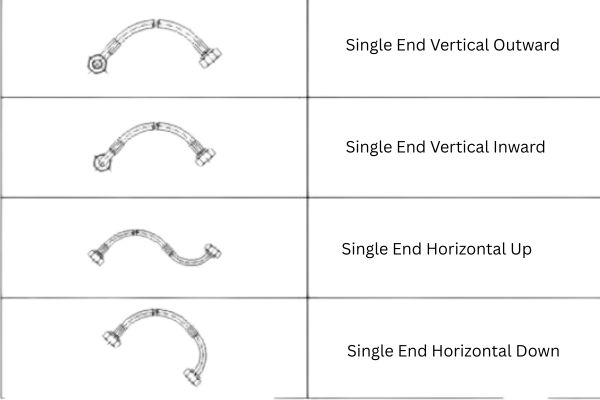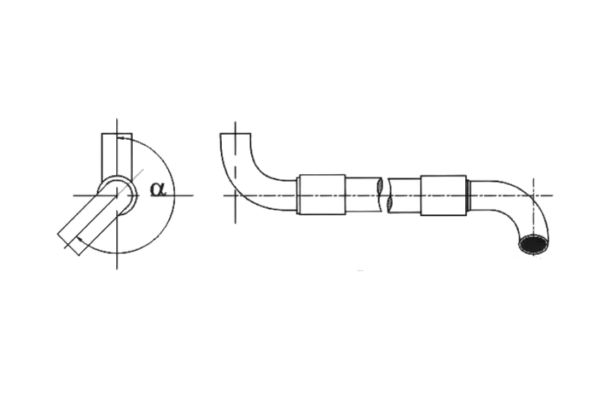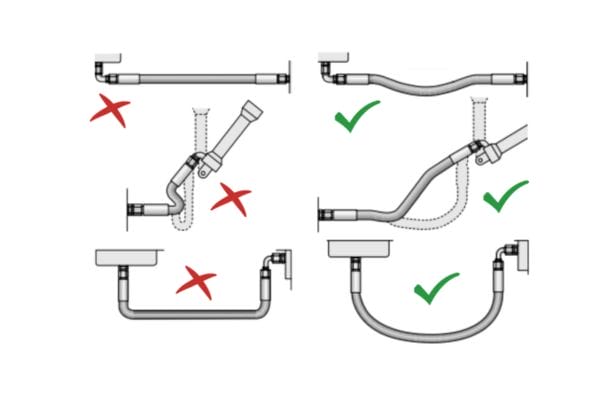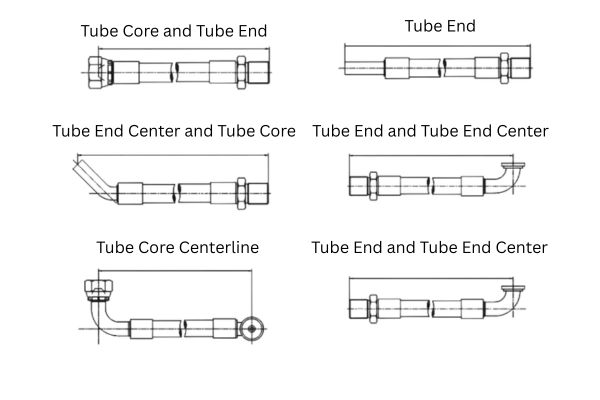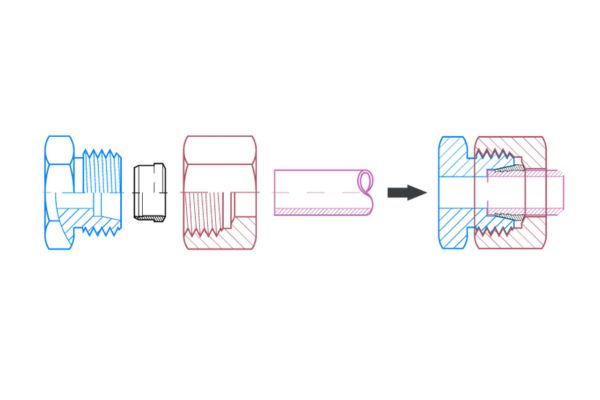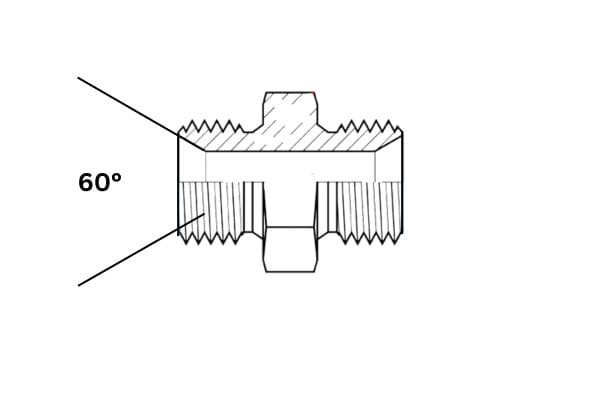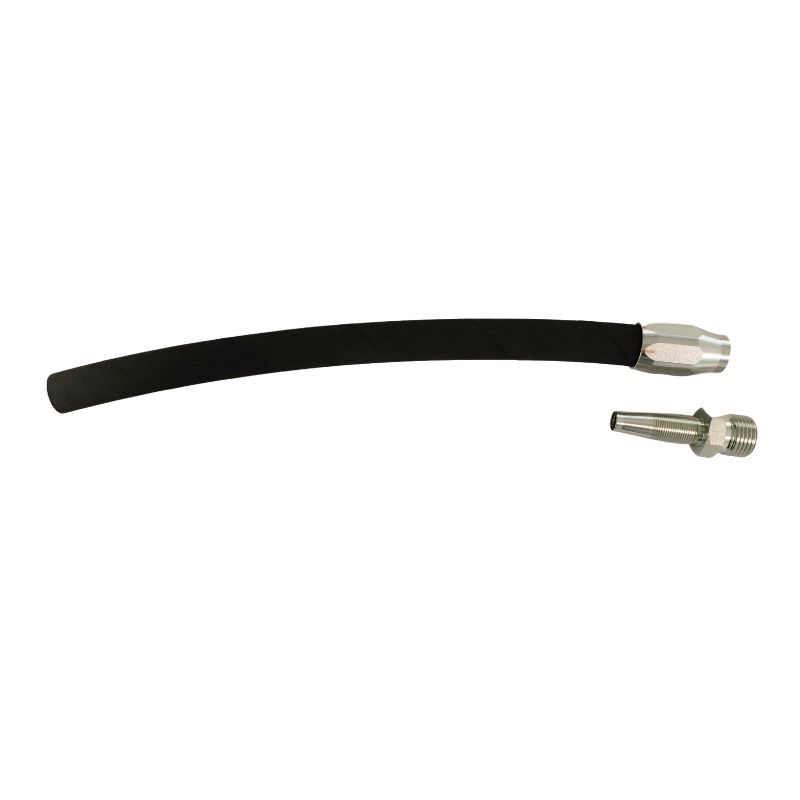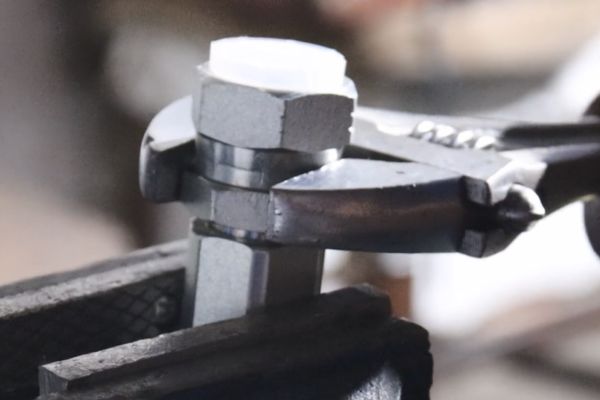That long line of text printed on a hydraulic hose looks like a secret code. Ordering the wrong replacement because you misread it leads to costly downtime, shipping delays, and even dangerous system failures.
This “layline” is actually a simple guide to everything you need to know. We will teach you how to decode it. By understanding the standard, construction, size, and pressure rating, you can select the perfect hose every time with complete confidence.
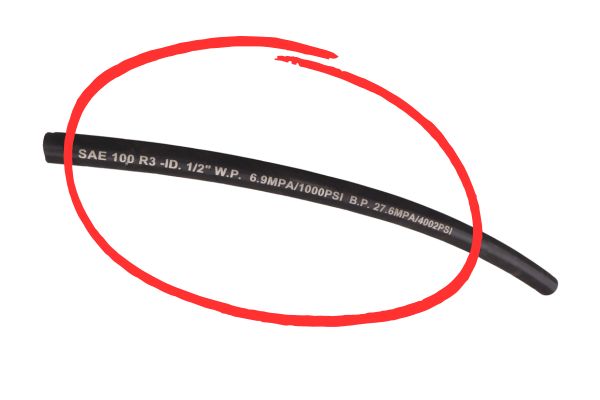
The layline is your most critical tool when identifying or replacing a hydraulic hose. It’s a permanent marking applied by the manufacturer that details the hose’s capabilities and specifications. Getting this right is fundamental to purchasing, maintenance, and safe operation.
What Are the Key Parts of a Hose Layline?
You see a string of codes like “EN 853 2SN DN13 38 MPa,” and it’s overwhelming. Guessing what it means can lead to buying a hose that doesn’t fit or can’t handle the pressure.
This code is your hose’s data sheet, printed right on its side. It tells you the standard it was built to, how it’s constructed, its size, and its maximum pressure. Understanding these four parts is the key to cracking the code.

Think of the layline as a universal language for hydraulic professionals. Once you learn the basic vocabulary, you can look at a hose from any major manufacturer and know exactly what it is. This knowledge empowers you to source replacements confidently from different suppliers, knowing you are getting a part that meets your performance and safety requirements. It removes the guesswork from a critical part of your job and ensures your machinery runs smoothly.
The Governing Standard
The first piece of information is often the manufacturing standard. This tells you which set of rules the hose was designed and tested against. Common standards include:
- SAE: Society of Automotive Engineers (A U.S. standard, globally recognized).
- EN: European Norm (The primary European standard).
- DIN: Deutsches Institut für Normung (A German standard, often superseded by EN).
- GB/T: A Chinese national standard.
The Hose Construction and Type
This part of the code tells you what the hose is made of, specifically its reinforcement. Codes like “R2AT,” “2SN,” or “4SP” describe the number and type of reinforcement layers. This directly relates to the hose’s pressure rating and flexibility. We will dive deeper into these codes in the next sections.
The Hose Size (Inner Diameter)
The size indicates the inner diameter (I.D.) of the hose. This is crucial for ensuring the correct flow rate in your system. Size can be listed in several ways:
- Dash Size: A two-digit number representing sixteenths of an inch (e.g., -08 = 8/16″ = 1/2″).
- Millimeters (mm): A direct metric measurement.
- Inches (“): A direct imperial measurement.
- DN (Nominal Diameter): A metric designation used in EN standards.
The Pressure Rating
This number tells you the maximum working pressure the hose is designed to handle safely. It is usually listed in either Megapascals (MPa) or pounds per square inch (PSI). This is perhaps the most critical safety specification on the hose, and it should never be ignored.
| Category | Description | Examples |
| Governing Standard | Standard used for design and testing. | SAE (US), EN (Europe), DIN (Germany), GB/T (China) |
| Hose Construction & Type | Indicates reinforcement layers and design, affects pressure rating and flexibility. | R2AT, 2SN, 4SP |
| Hose Size (I.D.) | Inner Diameter shown in different formats. | -08 (Dash Size), 12 mm, 1/2″, DN12 |
| Pressure Rating | Maximum safe working pressure, given in MPa or PSI. | 21 MPa, 3000 PSI |
How Do I Decode a Common SAE Hose Marking?
You have a hose marked “SAE 100R2AT -08,” and you need an exact replacement. Not knowing what “R2AT” means could lead you to buy a less durable hose that fails prematurely.
This is one of the most common hose types in North America. “SAE 100” is the standard, “R2” means it has two layers of steel wire braid reinforcement, “AT” specifies certain details, and “-08” means the inner diameter is 1/2 inch.
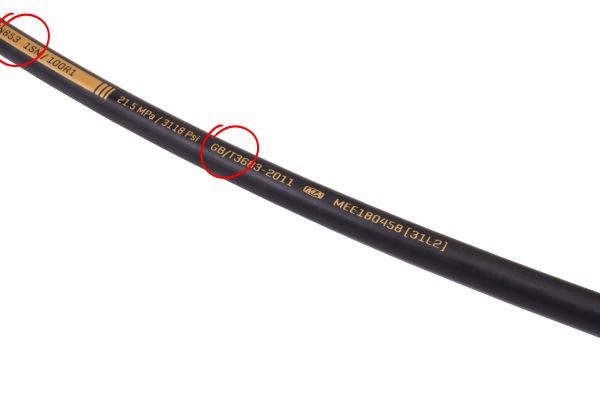
The SAE J517 standard defines a series of “100R” hose types. Each type has specific construction and performance requirements. Understanding these common codes will allow you to identify the vast majority of hoses used on American-made equipment. It’s the foundational knowledge for any maintenance professional working with hydraulics. Once you learn this, the rest of the puzzle starts to fall into place.
The “SAE 100R” Series Standard
The SAE 100R designation is a family of hose types. The number after the “R” indicates the specific construction and application. For example:
- R1: One layer of steel wire braid.
- R2: Two layers of steel wire braid.
- R4: Suction and return line hose.
- R12: Four-spiral wire hose for high-pressure service.
- R13: Multi-spiral hose for very high pressure.
- R16: A more compact two-wire braid hose.
Decoding the Type “R2”
The “R2” in our example is very specific. It tells a buyer or user that the hose is reinforced with two layers of high-tensile steel wire braid. This is a very common construction for medium-to-high pressure applications on equipment like tractors, skid steers, and industrial machinery. A hose marked “R1” would have only one layer and a lower pressure rating.
What the “AT” Suffix Means
The “AT” suffix is a detail from older versions of the SAE standard. It technically meant that the outer rubber cover did not need to be “skived” (shaved off) before attaching a fitting. Today, almost all modern hoses are non-skive. While the “AT” is often still printed on the hose for legacy reasons, R1 and R2 hoses are now generally grouped under the EN standards of 1SN and 2SN, which we will cover next.
What About European EN Hose Standards?
You’re working on a European machine and the hose is marked “EN 853 2SN DN12.” This looks different from the SAE code you’re used to, and you need to find a compatible replacement.
This is a European standard hose. “EN 853” is the spec for wire braid hoses, “2SN” means it has two layers of wire braid (similar to R2AT), and “DN12” is the nominal size, corresponding to a 1/2 inch or -08 dash size.
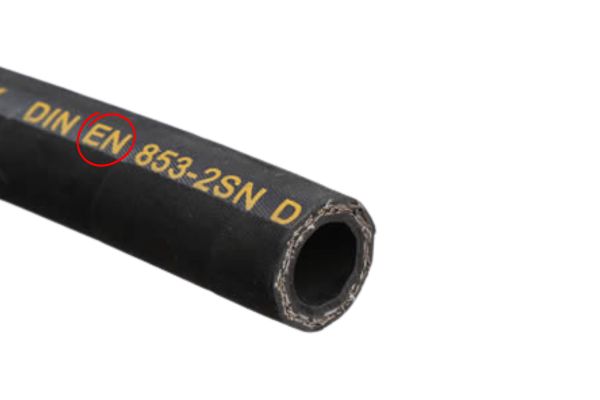
European Norm (EN) standards have become globally prevalent, and many manufacturers now produce hoses that meet both SAE and EN requirements. The EN system is very logical and easy to understand. Learning to cross-reference between SAE and EN standards will greatly expand your ability to source the correct parts for a wider variety of machinery from all over the world. It’s a very valuable skill.
Understanding the EN Standard Families
The primary EN standards for hydraulic hose are divided by construction type:
- EN 853: Covers wire braid hoses.
- EN 854: Covers textile (fiber) braid hoses.
- EN 855: Covers thermoplastic hoses.
- EN 856: Covers wire spiral hoses.
If you know these four families, you can instantly identify the basic hose construction just by reading the first part of the code.
Decoding the “SN” and “SH” Codes
The “SN” and “SH” codes provide more detail, especially for wire braid hoses under the EN 853 standard.
- 1SN: One layer of steel wire braid, standard cover.
- 2SN: Two layers of steel wire braid, standard cover.
- 1ST: One layer of steel wire braid, thin cover (older).
- 2ST: Two layers of steel wire braid, thin cover (older).
The “SN” types have largely replaced the “ST” types and are directly comparable to the common SAE hoses.
Cross-Referencing SAE and EN Hoses
For the most common medium-pressure hoses, the types are interchangeable for most applications. This makes sourcing much simpler.
| Common SAE Type | Equivalent EN Type | Construction |
| SAE 100R1AT | EN 853 1SN | One-Wire Braid |
| SAE 100R2AT | EN 853 2SN | Two-Wire Braid |
| SAE 100R16 | EN 857 1SC | One-Wire Braid (Compact) |
| SAE 100R17 | EN 857 2SC | Two-Wire Braid (Compact) |
This table is a critical tool for any procurement manager or technician. It allows you to confidently substitute a 2SN hose if an R2AT is specified, ensuring you get a part with the same performance.
How Do I Tell Braided vs. Spiral Hoses Apart?
The layline says “4SP” or “4SH” instead of “2SN.” You know it’s a four-wire hose, but you don’t know what “SP” or “SH” means or why it matters for your high-pressure application.
The letters “SP” and “SH” indicate a spiral wound hose, not a braided one. Braided hoses have crisscrossing wire layers for flexibility, while spiral hoses have parallel wires wrapped in layers for maximum strength and impulse resistance in very high-pressure systems.
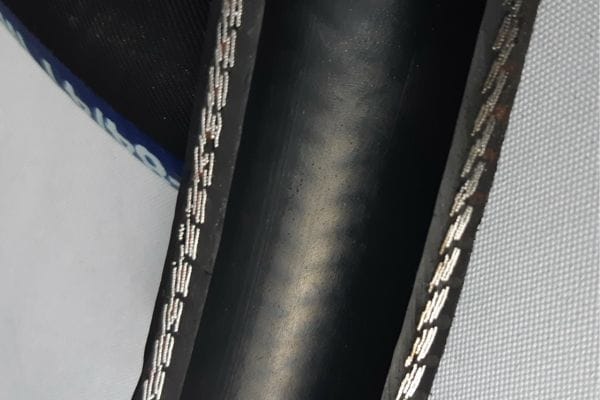
This is one of the most important distinctions in hydraulic hose construction. While both use steel wire for reinforcement, the way that wire is applied fundamentally changes the hose’s behavior. Choosing the wrong one can lead to premature failure. Spiral hoses are built for the intense, pulsating pressures found on large excavators and industrial presses, whereas braided hoses are the flexible workhorses for general applications.
Characteristics of Wire Braid Hoses
Hoses like 1SN and 2SN have wire reinforcement that is braided together like a net around the inner tube.
- Flexibility: The braided construction allows for greater flexibility and a tighter minimum bend radius.
- Applications: They are ideal for mobile equipment, farm machinery, and industrial lines where hoses need to move and flex.
- Codes: Look for “SN,” “ST,” or the SAE “R” numbers like R1, R2, R16, R17.
Characteristics of Wire Spiral Hoses
Hoses under the EN 856 standard (like 4SP and 4SH) have layers of high-tensile wire wrapped in parallel spirals.
- Strength & Impulse Resistance: This construction is much stronger and better at resisting the damaging effects of repeated high-pressure spikes (impulses).
- Applications: They are required for heavy-duty construction equipment, hydrostatic drives, and systems with extreme pressure demands.
- Codes: Look for “SP” (Standard Spiral) and “SH” (Super High-Pressure Spiral). Common types are 4SP and 4SH, with R12, R13, and R15 being the SAE equivalents.
When to Choose Braid vs. Spiral
| Feature | Wire Braid (e.g., 2SN) | Wire Spiral (e.g., 4SP) |
| Primary Advantage | Flexibility, smaller bend radius | Strength, impulse life |
| Pressure Range | Medium to High | High to Very High |
| Common Use | Mobile equipment, general hydraulics | Excavators, presses, hydrostatic drives |
| Cost | Lower | Higher |
| Stiffness | More flexible | Stiffer and heavier |
What Do Pressure Ratings Actually Mean?
The hose says “Max Working Pressure 40 MPa,” but you know your system sometimes spikes higher. Ignoring this number is tempting, but it can lead to a dangerous hose burst.
The stated pressure is the **Maximum Allowable Working Pressure (MAWP)**. It is the highest pressure the hose can safely and continuously operate at. Hydraulic systems are designed with a safety factor, meaning the hose’s actual burst pressure is much higher, but you must never exceed the working pressure.
Safety in hydraulics is paramount. A hose failure at high pressure can release a jet of hot oil at near-supersonic speed, capable of causing severe injury or death. The pressure rating is not a suggestion; it’s a hard limit determined through extensive testing.
Working Pressure vs. Burst Pressure
These are two different but related numbers.
- Working Pressure (MAWP): The maximum pressure for normal, continuous operation. All system design should be based on this number.
- Burst Pressure: The pressure at which the hose will physically rupture. This is a destructive test value, not an operational one.
The Industry Standard 4:1 Safety Factor
For most industrial and mobile hydraulics, hoses are designed with a 4:1 safety factor. This means the minimum burst pressure is four times the maximum allowable working pressure.
- A hose with a Working Pressure of 3,000 PSI is designed to have a minimum Burst Pressure of 12,000 PSI.
This safety margin accounts for minor pressure spikes, hose aging, and slight wear and tear. It is not extra capacity for you to use.
Why You Must Never Exceed Working Pressure
Operating a hose above its MAWP, even if it’s below the burst pressure, is extremely dangerous. It will drastically shorten the life of the hose by over-stressing the wire reinforcement. This leads to premature fatigue and a sudden, unexpected failure. Always select a hose with a MAWP that is equal to or greater than the maximum normal operating pressure of your system, including any common spikes.
Are There Other Important Markings on a Hose?
You’ve decoded the main P.A.S.S. elements, but there are other numbers and symbols. Ignoring them could mean you fail a safety inspection or use a hose that is too old.
Yes, many hoses include other critical data. You should look for a manufacturing date code to ensure the hose is not too old, as well as any special certifications like MSHA (for mining) or temperature ratings that are vital for specific applications.
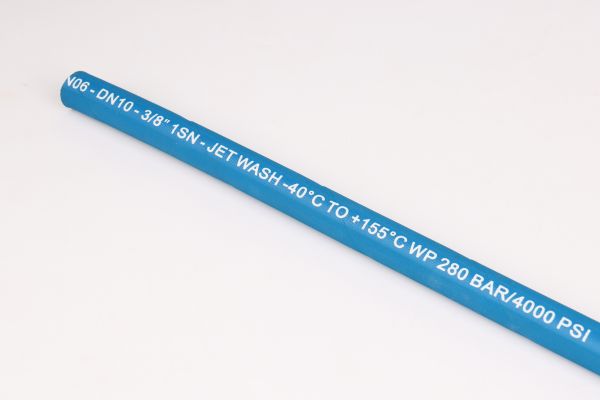
Finding the Manufacturing Date Code
Rubber has a limited shelf life. Most manufacturers print a date code on the hose, often in the format of Quarter/Year (e.g., “Q3 23” means the hose was made in the third quarter of 2023). It is good practice to avoid using hoses that are more than 5-7 years old, even if they have never been in service, as the rubber can degrade over time.
MSHA (Mine Safety and Health Administration) Certification
If a hose is intended for use in underground mining, it must have an MSHA certification printed on its layline. This marking (e.g., “MSHA IC-40/32”) indicates that the hose cover has been tested and approved as being flame-resistant, a critical safety feature to prevent fires in a mine environment. Using a non-MSHA hose in a mine is a serious safety violation.
Temperature and Fluid Compatibility Ratings
Some laylines will also include the maximum temperature rating (e.g., “100°C / 212°F”) or symbols indicating compatibility with specific fluids like phosphate esters. Always check these details if your application involves extreme temperatures or non-standard hydraulic fluids to prevent hose degradation and failure.
Conclusion
The layline on a hydraulic hose is not a secret code. It is a clear and concise data sheet designed to help you. By understanding the standard, construction, size, and pressure, you can make safe and intelligent purchasing decisions that keep your machinery running efficiently and your workplace safe.
Choose Topa hydraulic hoses for reliable performance in the toughest conditions. Our hoses meet international standards, offering excellent pressure resistance, flexibility, and long service life. Contact us today to place your order and keep your equipment running safely and efficiently.
FAQ
What is a hose layline?
A layline is the printed text on the hose that shows its standard, construction, size, and pressure rating.
Why is the layline important?
It helps you identify the correct replacement hose and avoid costly or dangerous mistakes.
How do I read hose size from the layline?
Sizes are shown as dash numbers (e.g., -08), millimeters (mm), inches (“), or DN values.
What does the pressure rating on the layline mean?
It shows the maximum safe working pressure (MAWP). The system must never exceed this value.
Can SAE and EN hoses be interchangeable?
Yes, many SAE and EN types match (e.g., SAE 100R2AT = EN 853 2SN). Always confirm specifications.
What other markings should I check on a hose?
Look for the manufacturing date code, MSHA certification, and temperature/fluid compatibility ratings.



